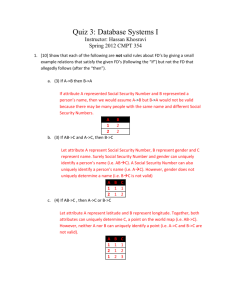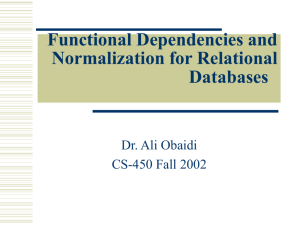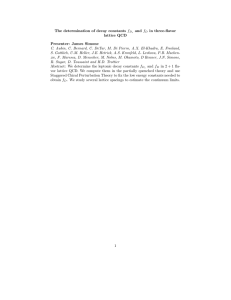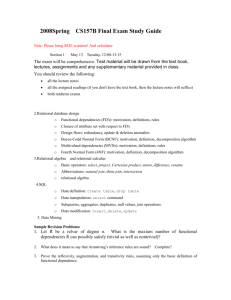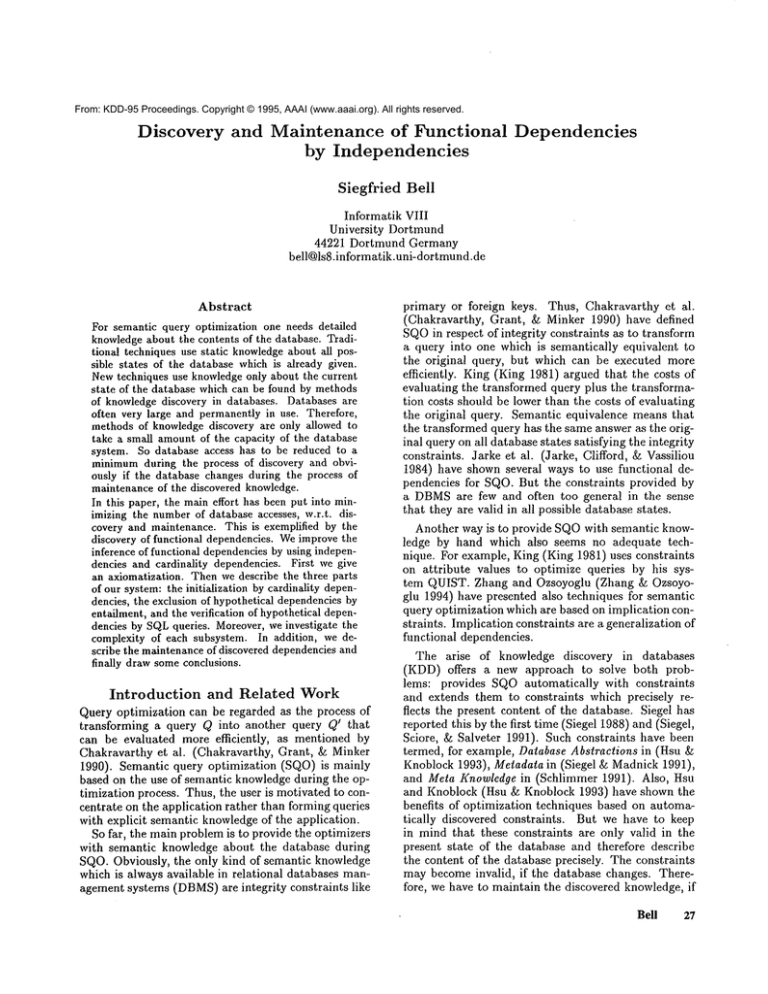
From: KDD-95 Proceedings. Copyright © 1995, AAAI (www.aaai.org). All rights reserved.
Discovery
and Maintenance of Functional
by Independencies
Siegfried
Dependencies
Bell
Informatik VIII
University Dortmund
44221 Dortmund Germany
bell@lsS.informatik.uni-dortmund.de
Abstract
For semantic query optimization one needs detailed
knowledgeabout the contents of the database. Traditional techniques use static knowledgeabout all possible states of the database whichis already given.
Newtechniques use knowledgeonly about the current
state of the database which can be found by methods
of knowledgediscovery in databases. Databases are
often very large and permanentlyin use. Therefore,
methodsof knowledgediscovery are only allowed to
take a small amountof the capacity of the database
system. So database access has to be reduced to a
minimumduring the process of discovery and obviously if the database changes during the process of
maintenanceof the discovered knowledge.
In this paper, the maineffort has been put into minimizing the numberof database accesses, w.r.t, discovery and maintenance. This is exemplified by the
discovery of functional dependencies. Weimprovethe
inference of functional dependenciesby using independencies and cardinality dependencies. First we give
an axiomatization. Then we describe the three parts
of our system: the initialization by cardinality dependencies, the exclusion of hypothetical dependenciesby
entailment, and the verification of hypothetical dependencies by SQLqueries. Moreover,we investigate the
complexity of each subsystem. In addition, we describe the maintenanceof discovered dependenciesand
finally drawsomeconclusions.
Introduction
and Related
Work
Query optimization can be regarded as the process of
transforming a query Q into another query Q~ that
can be evaluated more efficiently,
as mentioned by
Chakravarthy et al. (Chakravarthy, Grant, & Minker
1990). Semantic query optimization (SQO) is mainly
based on the use of semantic knowledgeduring the optimization process. Thus, the user is motivated to concentrate on the application rather than forming queries
with explicit semantic knowledgeof the application.
So far, the main problem is to provide the optimizers
with semantic knowledge about the database during
SQO. Obviously, the only kind of semantic knowledge
which is always available in relational databases management systems (DBMS)are integrity constraints like
primary or foreign keys. Thus, Chakravarthy et al.
(Chakravarthy, Grant, & Minker 1990) have defined
SQOin respect of integrity constraints as to transform
a query into one which is semantically equivalent to
the original query, but which can be executed more
efficiently. King (King 1981) argued that the costs
evaluating the transformed query plus the transformation costs should be lower than the costs of evaluating
the original query. Semantic equivalence means that
the transformed query has the same answer as the original query on all database states satisfying the integrity
constraints. Jarke et al. (Jarke, Clifford, &Vassiliou
1984) have shown several ways to use functional dependencies for SQO. But the constraints provided by
a DBMSare few and often too general in the sense
that they are valid in all possible database states.
Another way is to provide SQOwith semantic knowledge by hand which also seems no adequate technique. For example, King (King 1981) uses constraints
on attribute values to optimize queries by his system QUIST. Zhang and Ozsoyoglu (Zhang & Ozsoyoglu 1994) have presented also techniques for semantic
query optimization which are based on implication constraints. Implication constraints are a generalization of
functional dependencies.
The arise of knowledge discovery in databases
(KDD) offers a new approach to solve both problems: provides SQOautomatically with constraints
and extends them to constraints which precisely reflects the present content of the database. Siegel has
reported this by the first time (Siegel 1988) and (Siegel,
Sciore, ~z Salveter 1991). Such constraints have been
termed, for example, Database Abstractions in (Hsu
Knoblock 1993), Metadala in (Siegel & Madnick 1991),
and Meta Knowledge in (Schlimmer 1991). Also, Hsu
and Knoblock (Hsu & Knoblock 1993) have shown the
benefits of optimization techniques based on automatically discovered constraints. But we have to keep
in mind that these constraints are only valid in the
present state of the database and therefore describe
the content of the database precisely. The constraints
may become invalid, if the database changes. Therefore, we have to maintain the discovered knowledge, if
Bell
27
we use it more than once.
Problmns arise if knowledgediscovery is applied to
real world databases which are continuously in use and
large. Therefore, knowledgediscovery ill databases is
only allowed to take a small portion of the system resources.
Comparable
to our approachin orderto discover
functional dependencies, there are similar ones by
Mannila and R/iih~i (Mannila & Riiildi 199l), Dehaspe
et al. (Dehaspe, Laer, & Raedt 1994), Savnik and
Flach (Savnik & Flach 1993), and Schlimmer (Schlimmer 1993). Mannila and Riiih~i have investigated the
problem of inferring FDs from examplerelations in order to determine database schemes. But they do not
use a complete inference relation regarding independencies. Sawfik and Flach have investigated a special
data structure for the FDs. Briefly, they start with a
bottom-up analysis of the tuples and construct a negative cover, whichis a set of FIs. In the next step they
use a top-down search approach. They check the validity of a dependencyby searching for FIs in the negative
cover. Also, the negative cover is not complete regarding a classical consequence relation. Schlimmeralso
uses a top-down approach, but in conjunction with a
hash-function in order to avoid redundant computations. However, he does not use a complete inference
relation even regarding functional dependencies. Also
do Dehaspeet al. because their inferences are based on
® subsumption. In addition, the verification is based
on theorem proving which is not suitable for real world
databases.
In general, these authors do not use a relational
database like OracleV7 or any other commercial
DBMS.In such case, we argue that the proposed algorithm and approaches have to redesign according the
set oriented interface of a relational database system.
For example, the concept of the negative cover has only
advantages if the tuples can be accessed directly, i.e.
the tuples are stored in the main memoryas Prologfacts. Savnik and Flach have introduced it because
the complexity for testing contradiction of the FDs is
reduced.
In contrast to these appproaches our purpose is different because we maintain the discovered FDs in order
to use them all the time by semantic query optimization.
In addition, we argue that by using a relational
database system, the higher complexity of the complete inference relation is justified by the size of a real
world database.
Wehave already investigated the discovery of value
restrictions,
unary inclusion dependencies, and timetional dependencies in relational databases and has implemented this approach by using the database management system ORACLE
(Bell & Brockhausen 1995).
Also, we have given an approach to test these dependencies by SQLstatements and have given an empirical
evaluation.
28
KDD--95
1
NULL
2
1
true
false
false
NULL
2
false
false
true
false
false
true
Figure 1: Equality operator
Thus, this paper focuses on minimizing the number
of accesses to the database w.r.t, the discovery of functional dependencies and their maintenance. The inference of functional dependencies is improved by using
functional independencies and by cardinality dependencies. Also, we regard Nu:l_:k values because they frequently arise in databases. Wegive an axiomatization
of these independencies and discuss the complexity of
the implemented inference relation which is given by
three algorithms. Then we describe dependency maintenance caused by insertion or deletion of tuples.
Functional
Independencies
In this section we discuss functional independencies
and their axiomatization. Weassume familiarity with
the definitions of relational database theory (see for
example (Kanellakis 1990)) and the basic properties
of the classical consequencerelation. The capital letters A, B, C,... denote attributes, and X, Y, Z denote
attribute sets. Wedo not distinguish between an attribute A and an attribute set {A}. Weomit proofs
when they are trivial. Rememberthat every attribute
is associated with a set of values, called its domain.
Functional dependencies are defined as usual. Additionally, we consider Null values because the ISO standard permits Nu].:I. values in any attribute of a candidate key. Therefore, we adopt a special equality operator for the definition of the FDs, ~, whichis illustrated
in figure 1.
The so called Armstrong’s Axiomsprovide a correct
and complete axiomatization for them and establish an
inference relation I-A.
Wenow can define the consequences of a set of dependencies. Let E be a set of functional dependencies,
then X ~ Y is a consequence of E, or X ---+ Y 6
Cn(E): whenevera relation satisfies E it satisfies X --+
Y. The closure of attributes X w.r.t, a set of FDs ?,
is defined as: closure(X, ~) = {Y I X ---+ Y e Cn(Z)}
and is denoted by X.
Functional independencies have been introdnced by
aan~ (aanas 1988) to mirror functional dependencies.
But they are meant for a totally different purpose: FIs
are not semantical constraints on the data, but a support for the database designer in the task of identifying
functional dependencies. In addition, they also help
to improve the inference of fimctional dependencies.
Wesimplify the definition of functional independencies here by ignoring Null values.
In (Paredaens el al. 1989) 1afunctional dependencies
are introduced, but they are a sort of semantic constraints and much stronger than our functional independencies. Therefore, we cannot use them to improve
the inference of FDs.
Definition
1 (Functional
Independency (FI))
X 74 Y denotes a functional independency. A relalion r satisfies X 7t* Y (r ~ X 74 Y) if there exist
tuples 11, t2 of r with tl[XI~-I2[X] and tl[Y]~t2[Y].
The consequences of FDs and FIs
follows: Let ~ be a set of FDs and
Cn(~ U ~,’) := {~l for each relation
then r ~ ~} where a is a FD or
called inconsistent, if there exists
X -~ Y e Cn(~. U ~’) and X ~ Y e
are defined as
~’ aset of FIs.
r if r M~ U ~’,
FI. ~ U ~’ is
a X 7¢ Y so that
Cn(~,U ~.’)
vice versa.
An axiomatization of FIs has already been given by
Janas (Janas 1988) which establishes an inference relation b..a,
Definition 2 (FIs) The axiomatization
given by:
XJ.Y
1. X~CYZ
2.
by Janas is
XZ~-~YZ
X ZTt, Y
3. x-,z, YC-,z
xc-,z
Weshow with a counterexample that this inference
relation is not complete, i.e. there exists someX 74 Y
with X 74 Y E Cn(EUZ’) and EU~.’ ~a,~ X 74
Lemma1 The following inference rule is correct:
z --,Y, ZTCY
Lemma2 { X --* Y, Z 74 Y } ~anas Z ~/-~ X.
Proof-" We assume that X, Y and Z are disjoint.
Then obviously the first and the second rule cannot
be applied to infer Z 74 X. Thus, the third rule can
be applied only. But Z is not in the closure of Y and
~], i.e. {X ~ Y} I;/A Y ---* Z. Thus, we cannot infer
x.
[]
Theorem 1 The axiomatization
by Janas (Janas
1988) is not complete.
Instead, we propose the following axiomatization:
Definition 3 (Inference of FIs) An inference relation ~-li is given by an axiomatization of the FDsand
the following inference rules:
FII:
FI2:
XV;I,
YW, W CV
xl~Y -
x-.Y,Y74ZXOZ
aThe definition of the ADX-//¢ Y requires that for
each tuple t there exists a tuple t’ so that fiX] -a t’[X] and
t[Y]~-t’[Y].
FI3:
Y---~Z,X?4Z
X74Y
For example, the functional independency X 74 YZ
which is a consequence of Janas’ first inference rule
can be inferred by P1i as follows: we infer YZ ~ Y by
Armstrong’s Axioms and use FI3 to infer a FIX 74 YZ
fromX74YandYZ~Y.
Theorem 2 (Soundness and Completeness)
The inference rules FI1 to FI3 are correct and complete for a consistent set of functional dependencies,
respectively independencies.
Proof: For details refer to (Bell 1995). A rough sketch
is as follows: First, it has to be shownthat the FIs do
not affect the inference of FDs. Second, that we can
infer from a set of FIs only trivial inferences, e.g. if
AB 74 C then A 74 Cor ifAB 74 C, then AB 74
CD. The last part can be seen by a negative proof
of Armstrong’s Axioms, or by a construction of the
certain possible cases.
[]
Inference
of Functional
Independencies
Our system consists of three elements: initialization,
entailment, and verification. It is roughly sketched in
table 1. First, we initialize our data structure List
for the FDs and FIs. Then, we generate hypothetical dependencies, check if these are already entailed
by the known dependencies or independencies, and
verify the remaining ones by querying the database.
Weuse a kind of breath first search because we generate only hypotheses which are not related by each
other. Terminating is ensured, because if no already
entailed hypotheses can be generated, then the algorithm stops. The algorithms are written in PROLOG
and connected to an OR.ACLE7
server by a SQLinterface via TCP/IP.
Verification
Functional dependencies can be verified by sorting the
tuples of the relation which takes O(n log n) time w.r.t.
the number of tuples, cf. (Mannila &RAthe. 1991).
our implementation we use the nvl statement in SQL
to handle the NULLvalues.
Entailment
Entailment of FDs is often discussed by studying if
[-A X ----+
Y holds where ~ is a set of FDs and
n = ]~4. This can be decided in linear time with appropriate data structures (Kanellakis 1990). By Lemma
2, we can easily construct an algorithm for testing FIs:
function ~ t3 ~’ I-fi X 74 Y;
begin
for eachV 74 W E ~’ do
if ~ I-A V --~ X and E [-A
then return Yes;
else return No;
end;
Y ~
Bell
W
29
CD-FI2: IxI>WI
Y~X
The correctness of these rules is indicated by the
fact that for every FDX --, Y equal X values demand
equal Y values. But this implies that there must exist
at least as many X values as Y values which can be
formulated only with independencies. This fact clearly
demonstrates the usefulness of FIs.
Unfortunately, it turned out that testing CDsby our
SQL-interface is as expensive as testing FDs2. Thus,
we check the cardinality of UCDsin a single pass for
each attribute and approximate CDsby the following
Lemmawithout a proof:
1. Initialize List.
2. Repeat
(a) Take an element t from List and generate
all tuples T with a fixed length that are
not entailed by List.
(b) Query DBserver for T.
(c) Add T to List and find a minimal cover
for it.
3. until no already entailed hypothesis can be
generated
Lemma3 Let A E X be the attribute with the maximal cardinality
and Y = B1,...,Bn.
If IA[ >_
Table 1: Description of our System
(IBxl...l~,~l),thenIXI_>Irl-
It is obvious that testing FIs takes O(n2) time where
n = max(E, E~). Correctness and completeness follow
immediately from the previous section.
The sets of FDs and FIs are usually very large. We
can reduce these sets taking into account the following observation: The set of functional dependencies is
partitioned into equivalence classes by the satisfiability definition. Each class of functional dependencies
specifies the sameset of admissible relations. As these
equivalence classes will typically contain a large number of elements, it is reasonable to define a suitable representation with a minimal number of elements. This
representation is usually called a minimal cover, see
(Maier 1980). Wecan simply extend the definitions
(Maier 1980) by using our inference relation t-]i:
Definition 4 (Minimal Cover) Let E be a minimal
set of FDs.
E’ is a set of FIs and is called minimal if for all
V 7c, WE Cn(E O E’) there exists no X ~c, y E E’
with E u E’\{X¢~ r} ~s, V ¢. W.
Therefore, minimizing can be done by repeated application of I-]i and takes O(na) time for some set of
FDs and FIs.
Initialization
The data structures of the FDs and FIs are initialized
with information about primary keys and sufficient
conditions for FIs. These conditions are given by the
cardinality of the attributes which were introduced by
Kanellakis et al. as Unary Cardinality Dependencies
(UCDs) in the unary case (Kanellakis, Cosmadakis,
Vardi 1983). Wehave extended these UCDsto the general case of CDsand have given an axiomatization in
(Bell t995). Thus, we propose the following two rules
as sufficient conditions for FIs:
Definition 5 (Cm’dinality
and Y be sets of attributes:
CD-FII: IXl>_lYI,
Y~XX;/~Y
30
KDD-95
of Attributes)
Let
X
Hence, we initialize our data structures of FDs and
FIs with CDsapproximated in this manner and the inference rule CD-FI2only. Since the numberof CDsis a
combinatorial function of the number of attributes, it
is easy to see that the number of CDsgrows exponentially w.r.t, the nmnber of attributes. Therefore, the
algorithm is in EXPTIME.But, as a matter of fact,
this approximation algorithm does not need any resources of the database system. In addition, the worst
cases arise only rarely.
Complexity
of the System
Our system is in EXPTIMEbecause there exist relations with the number of PDs in a minimal cover
growing exponentially w.r.t, the number of attributes.
This has been shown by Mannila and R~iih/i (Mannila
&R/iih~i 1991). As there are relations with the munber
of FIs growing exponentially the performance cannot
be improved by using FIs instead of FDs.
Theorem 3 (Cardinality
of the set of FIs)
For each n there exisls a relation r which satisfies
minimumcover of FIs with lhe cardinality f~(2n/2).
a
Proofi see (Bell 1995).
[]
If the relation of Mannila and R/iih~i is added to
ours, then it is easy to see that relations exist where
the sets of FDs and FIs grow exponentially w.r.t, the
number of attributes. Again, we argue that our goal,
to minimize database access, can be achieved with this
system.
Maintenance of FDs
Obviously, the discovered FDs can become invalid,
because they only describe the current state of the
database. Therefore, the discovered FDs have to be
maintained if new tuples are added, old tuples are
deleted, or existing tuptes are updated.
If maintenance of FDs is seen as revision, it is more
suitable to do theory revision than base revision as
2Wecan only count the numberof values of single attributes by the SQLstatement count.
z.:={}
for each A1,..., Aa --* B1, ¯ ¯., BmE E do
begin
bl,...,brn,Cl,...,cI
:=
select B1,. ¯., Bin, C1,¯ ¯., Cz
from r
whereAi, = ail, ¯ ¯ ¯, Ai,, = aim
ifAi=o ..... mbi=d-+i then
En := En UAI,...,An -* B1,...,Bin
else begin
E := E\A1,...,A, --o B1,...,Bm
if there is a minimal u with C5,... , Cl~
andAi=l ..... vdt~ ~ ct~ then
E~ := En UA1,...,An,Ch,...,C~
B1,..., Bm
end
end
Table 2: Algorithm for Inserting NewTuples
introduced by G~irdenfors (G~irdenfors 1988). In contrast to theory revision, base revision works on the
whole consequnce set So it is easy to see, for example,
that by adding a new tuple the second FD of the set
{AB ---* CD, CD~ EF} may become invalid, but the
AB ---* EFremains valid. Therefore, in a first step the
minimal set of FDs E is transformed into a set Emof
FDs. This new set is called most general and can be
computed with the following algorithm:
for each X ---* Y E E do
if Y = closure(X, E)\X then
Obviously, the complexity depends on the cardinality of E and the closure operation which is mentioned
above.
Inserting
Tuples
If new tuples are added, FDs may become invalid. Thus, each FDis checked if it is still valid.
If not then the FD has to be replaced by a set of
FDs which are valid. The algorithm is listed in table 2 and is applied before the tuple is inserted.
Let (dl,...,dn+m+t)
be the new tuple, r the corresponding relation with the relation scheme R =
(A1,...,An,B1,...,Bm,C1,...,Ct),
A1,...,A,
---*
B1,..., Bmthe selected FDand CI,..., Ci the remaining attributes. The ci can consist of values and that
we expand the left hand side of each invalid FD by
attributes which values are different from the selected
ones.
The advantage of this algorithm is that it only one
simple query for each new tuple and for each FD is
needed. It is easy to see that the removed FDs are
no longer valid. For the correctness, we first give the
following lemma:
Lemma4 Each generated FD is valid.
Proof: We call the new tuple tl. We know that
AI,...,An,
B1,...,B,~
is invalid. Then there must
be
at
least
one tuple t2 so that tl [As,..., An]~- t2[A1,..., Aa] and
tl[B1,...,Bm]~t2[B1,...,B,,].
We know by construction that tl[Ch,..., Ct~]~t2 [Ch, . . ., Ct~]. Hence,
and
tl IX, Ch,. . ., Ct~]~t~[X, Ch,. . . , Ct,]
A1,...,A,,Ch,...,Ct~
--~ B1,...,Bin is valid.
[]
Completeness can now be seen by the following
lemma:
Lemma5 Let E be the former set of FDs and En be
the revised set of FDs. rn is obtained by expandingr by
one tuple. Assume that E ~ X --* Y and r ~ X --* Y.
If En ~ X---* Y, then rn ~ X ~ Y.
Proof." By correctness we only add valid FDs. By
minimality of the added attributes to the LHSof the
FD, it is guaranteed that an FDwith less attributes at
the LHSis not valid.
[]
Weconclude that if our algorithm is applied on E
and the result is E~, then r ~ ~ E~ by the lemmas.
Deleting
Tuples
Deleting tuples does not affect the old set of FDs, but
some new FDs may become valid. Therefore, we have
to revise the FDs and add new FDs if necessary. Unfortunately it turned out, that deleting tuples is the
same as discovering FDs with a given starting set of
FDs. Therefore computation in this case can be as
expensive as the discovery process.
Updating
Tuples
Normally, updating tuples can be seen as a combination of deleting and inserting tuples. But sometimeswe
can simplify this process by comparing the old values
with the new ones.
Assume that d = (al,...,a~,bl,...,bm,cl,...,cg)
is the tuple which will be updated by the values
(a~,.. ¯ ,an,bl,...,bin,el,.
’ ’
’ ’ .. c~),, and the selected
is A1,...,An ~ B1,...,Bm.
¯ If the values of the attributes of the left and the right
hand side do not change, then we have nothing to
do.
¯ If Ai=l ......
bl = b~ and at least one value of Ai,
1 < i < n, does not occur in r, then we have only to
apply the algorithm for deleting tuples.
Discussion
Our goal has been to minimize database access during
the discovery of FDs and the maintenance of the discovered FDs. Wehave shown, that this can be achieved
by the axiomatization of functional dependencies and
independencies presented in this paper and the use of
Bell
31
cardinality dependencies. The alternative to a complete inference wouldbe a more or less exhaustive test
of FDs oll tile database. Usually, real world databases
are very large, tile numberof tuples is muchlarger than
the number of attributes. Tile main costs of database
management systems are caused by reading from secondary memory. Therefore, a single saved database
query makesup for tile costs of inferring FDs and FIs.
This is true for tile maintenance, too.
Basically, our system is to discover candidate keys
because these can be used efficiently for optimization
techniques. Candidate keys are based on FDs so we
have concentrated on only discovery of FDs. In general, algorithms for discovering PDs are in EXPTIME
w.r.t, the number of attributes. Wehave already investigated discovering foreign keys which play also an
important role in SQO.
Currently, we are investigating tile use of data dependencies in semantic query optimization.
Acknowledgment: I would like to thank Peter
Brockhausen, Martin Mfihlenbrock, Steffo Weber and
Sabine Wohlrab for comments. This work is partly
supported by the European Community (ESPRIT Basic Research Action 6020, project Inductive Logic Programming).
References
Bell, S., and Brockhausen, P. 1995. Discovery of
constraints and data dependencies in databases (extended abstract). In Lavrac, N., and Wrobel, S., eds.,
Machine Learning: ECML-95(Proc. European Conf.
on Machine Learning, 1995), Lecture Notes in Artificial Intelligence 914, 267 - 270. Berlin, Heidelberg,
NewYork: Springer Verlag. An extended version is
also available as Research Report by the authors.
Bell, S. 1995. Inferring data independencies. Technical Report 16, University Dortmund, Informatik VIII,
44221 Dortmund, Germany.
Chakravarthy, U. S.; Grant, J.; and Minker, J. 1990.
Logic-based approach to semantic query optimization. ACMTransaction on Database Systems 15(2).
Dehaspe, L.; Laer, W. V.; and Raedt, L. D. 1994.
Applications of a logical discovery engine. In Wrobel,
S., ed., Proe. of the Fourth International Workshop
oll hlductive Logic Programmiug, GMD-StudienNr.
237, 291-304. St. Augustin, Germany: GMD.
G~rdenfors, P. 1988. Knowledge in Flux -- Modeling
the Dynamics of Epistenlic Slates. Cambridge, MA:
MIT Press.
Hsu, C.-N., and Knoblock, C. A. 1993. Learning
database abstractions for query reformulation. In
Knowledge Discovery in Database, Workshop, AAAI93.
Janas, J. M. 1988. Covers for functional independencies. In Conference of Database Theory. Springer,
Lecture Notes in Computer Science 338.
32
KDD-95
Jarke, M.; Clifford, J.; and Vassiliou, Y. 1984. An
optimizing prolog front-end to a relational query system. ACMSIGMOD.
Kanellakis, P.; Cosmadakis, S.; and Vardi, M. 1983.
Unary inclusion dependencies have polynomial time
inference problems. Proc. 15th Annual ACMSymposium on Theory of Computation.
Kanellakis, P. 1990. Formal Models and Semantics,
Handbookof Theoretical ComputerScience. Elsevier.
chapter Element.s of Relational Database Theory, 12,
1074 - 1156.
King, J. J. 1981. Query optimization by semantic reasoning. Technical Report STAN-CS-81-857,Stanford
University.
Maier, D. 1980. Minimumcovers in tile relational
database model. Journal of the A CM27(4):664 - 674.
Mannila, H., and RS.ih~i, K.-J. 1991. The design of
relational databases. Addison-Wesley.
Paredaens, J.; de Bra, P.; Gyssens, M.; and van
Gucht, D. 1989. The Structure of the Relational
Database Model. Springer Verlag Berlin Heidelberg.
Savnik, I., and Flach, P. 1993. Bottum-upindution of
functional dependencies from relations. In PiatetskyShapiro, G., ed., KDD-93: Workshop on Knowledge
Discovery in Databases. AAAI.
Schlimmer, J. C. 1991. Database consistency via
inductive learning. In Eight International Conference
on Machine Learning.
Schlimmer, J. 1993. Using learned dependencies to
automatically construct sufficient and sensible editing
views. In Piatetsky-Shapiro, G., ed., KDD-93:Workshop on KT~owledgeDiscovery in Databases. AAAI.
Siegel, M., and Madnick, S. M. i991. A metadata approach to resolving semantic conflicts. In Conference
on Very Lalye Databases.
Siegel, M.; Sciore, E.; and Salveter, S. 1991. Rule
discovery for query optimization. In KnowledgeDiscovery in Databases. Menlo Park: AAAIPress. chapter 24.
Siegel, M. D. 1988. Automatic rule derivation for
semantic query optimization. In Second International
Conference on Expert Database Systems.
Zhang, X., and Ozsoyoglu, Z. M. 1994. Reasoning
with implicational and referential constraints in semantic query optimization.
In Workshop on Constraiuts and Databases, Post-lLPS.

